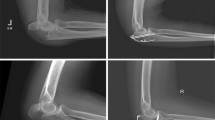Abstract
Background
Although open reduction and internal fixation (ORIF) is a standard fracture treatment method, the optimal way to expose a fracture prior to ORIF is debated. We compared the effects of two exposure methods, the triceps-sparing approach and olecranon osteotomy, on the functional outcomes of ORIF-treated type C distal humerus fractures in elderly people.
Methods
From January 2006 to January 2011, 75 elderly patients with type C distal humerus fractures were treated with ORIF, and we retrospectively reviewed their medical records, radiographs, and follow-up charts to identify any complications. Patients’ Mayo Elbow Performance Score (MEPS) and range of motion were determined at their final clinic visit.
Results
Sixty-seven patients (89 %) attended the final visit. Of these patients, 36 received olecranon osteotomy and 31 received the triceps-sparing approach. For patients with type C1 and C2 fractures, we observed reductions in procedure times, blood loss, complication rates, and MEPS outcomes (all P < 0.01) with the triceps-sparing approach compared with olecranon osteotomy. Except for MEPS outcomes, all of these approach-related improvements were also statistically significantly for type C3 fractures (all P < 0.01). Overall, we did not observe any cases of fracture nonunion, implantation breakage or loosening, or elbow stiffening in our series.
Conclusions
In our study, we found better functional outcomes for type C1 and C2 distal humerus fractures that were exposed using the triceps-sparing approach rather than olecranon osteotomy. Even for the most complex type of fracture, C3 fractures, similar recoveries in elbow function were achieved using either approach.
Level of evidence
Level III.






Similar content being viewed by others
References
Zlotolow DA, Catalano LW 3rd, Barron OA, Glickel SZ (2006) Surgical exposures of the humerus. J Am Acad Orthop Surg 14:754–765
Bryan RS, Morrey BF (1982) Extensive posterior exposure of the elbow. A triceps-sparing approach. Clin Orthop Relat Res 166:188–192
Erpelding JM, Mailander A, High R, Mormino MA, Fehringer EV (2012) Outcomes following distal humeral fracture fixation with an extensor mechanism-on approach. J Bone Jt Surg Am 94:548–553
Chen G, Liao Q, Luo W, Li K, Zhao Y, Zhong D (2011) Tricep-sparing versus olecranon osteotomy for ORIF: analysis of 67 cases of intercondylar fractures of the distal humerus. Injury 42:366–370
Broberg MA, Morrey BF (1986) Results of delayed excision of the radial head after fracture. J Bone Jt Surg Am 68:669–674
Hastings H 2nd, Graham TJ (1994) The classification and treatment of heterotopic ossification about the elbow and forearm. Hand Clin 10:417–437
Koh KH, Lim TK, Lee HI, Park MJ (2013) Surgical release of elbow stiffness after internal fixation of intercondylar fracture of the distal humerus. J Shoulder Elb Surg 22:268–274
Nauth A, McKee MD, Ristevski B, Hall J, Schemitsch EH (2011) Distal humeral fractures in adults. J Bone Jt Surg Am 93:686–700
Frankle MA, Herscovici D Jr, DiPasquale TG, Vasey MB, Sanders RW (2003) A comparison of open reduction and internal fixation and primary total elbow arthroplasty in the treatment of intra-articular distal humerus fractures in women older than age 65. J Orthop Trauma 17:473–480
Muller LP, Dietz SO, Rommens PM, Morrey BF (2003) Total elbow replacement as primary treatment for complex fractures of the distal osteopenic humerus. Eur J Trauma 29:63–67
McKee MD, Veillette CJ, Hall JA, Schemitsch EH, Wild LM, McCormack R et al (2009) A multicenter, prospective, randomized, controlled trial of open reduction—internal fixation versus total elbow arthroplasty for displaced intra-articular distal humeral fractures in elderly patients. J Shoulder Elb Surg 18:3–12
Jost B, Adams RA, Morrey BF (2008) Management of acute distal humeral fractures in patients with rheumatoid arthritis. A case series. J Bone Jt Surg Am 90:2197–2205
Korner J, Lill H, Müller LP, Hessmann M, Kopf K, Goldhahn J et al (2005) Distal humerus fractures in elderly patients: results after open reduction and internal fixation. Osteoporos Int 16(Suppl 2):S73–S79
Wagner M (2003) General principles for the clinical use of the LCP. Injury 34(Suppl 2):B31–B42
Korner J, Lill H, Muller LP, Rommens PM, Schneider E, Linke B (2003) The LCP concept in the operative treatment of distal humerus fractures: biological, biomechanical and surgical aspects. Injury 34:B20–B30
Soon JL, Chan BK, Low CO (2004) Surgical fixation of intra-articular fractures of the distal humerus in adults. Injury 35:44–54
Shin SJ, Sohn HS, Do NH (2010) A clinical comparison of two different double plating methods for intraarticular distal humerus fractures. J Shoulder Elb Surg 19:2–9
Kaiser T, Brunner A, Hohendorff B, Ulmar B, Babst R (2011) Treatment of supra- and intra-articular fractures of the distal humerus with the LCP Distal Humerus Plate: a 2-year follow-up. J Shoulder Elb Surg 20:206–212
Ljungquist KL, Beran MC, Awan H (2012) Effects of surgical approach on functional outcomes of open reduction and internal fixation of intra-articular distal humeral fractures: a systematic review. J Shoulder Elb Surg 21:126–135
Tak SR, Dar GN, Halwai MA, Kangoo KA, Mir BA (2009) Outcome of olecranon osteotomy in the trans-olecranon approach of intra-articular fractures of the distal humerus. Ulus Travma Acil Cerrahi Derg 15:565–570
Schmidt-Horlohé K, Wilde P, Bonk A, Becker L, Hoffmann R (2012) One-third tubular-hook-plate osteosynthesis for olecranon osteotomies in distal humerus type-C fractures: a preliminary report of results and complications. Injury 43:295–300
Aktekin CN, Toprak A, Ozturk AM, Altay M, Ozkurt B, Tabak AY (2008) Open reduction via posterior triceps sparing approach in comparison with closed treatment of posteromedial displaced Gartland type III supracondylar humerus fractures. J Pediatr Orthop B 17:171–178
Wilkinson JM, Stanley D (2001) Posterior surgical approaches to the elbow: a comparative anatomic study. J Shoulder Elb Surg 10:380–382
Conflict of interest
None declared.
Author information
Authors and Affiliations
Corresponding author
Rights and permissions
About this article
Cite this article
Zhang, C., Zhong, B. & Luo, Cf. Comparing approaches to expose type C fractures of the distal humerus for ORIF in elderly patients: six years clinical experience with both the triceps-sparing approach and olecranon osteotomy. Arch Orthop Trauma Surg 134, 803–811 (2014). https://doi.org/10.1007/s00402-014-1983-y
Received:
Published:
Issue Date:
DOI: https://doi.org/10.1007/s00402-014-1983-y




